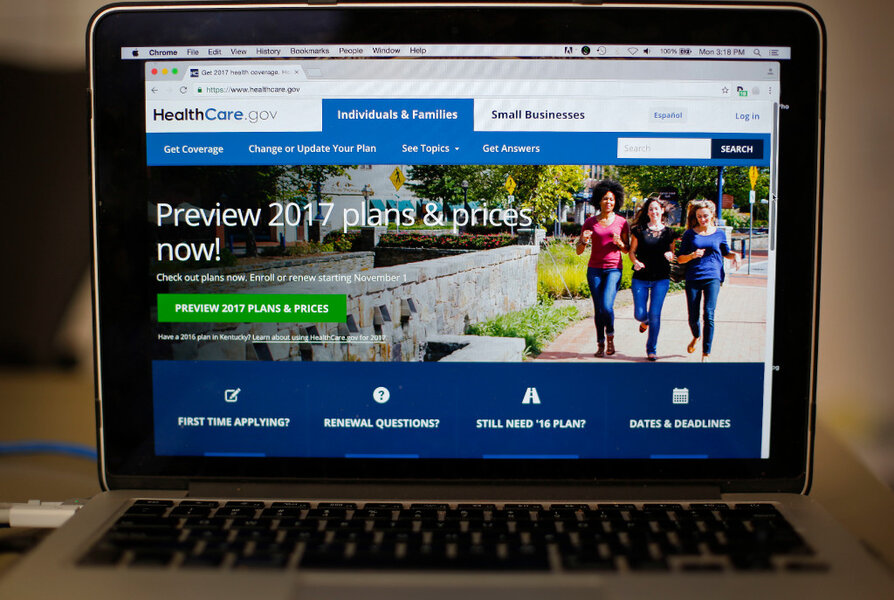Less than one month left for ‘Obamacare’ shoppers
Loading...
Here’s one resolution you should check off early in the year: choosing a health plan if you don’t already have one. The deadline to buy a plan under the Affordable Care Act mandate is Jan. 31.
If you don’t choose a plan by the deadline and pay the first payment when it’s due, you won’t be able to get coverage this year, with few exceptions. If you lack health coverage for more than three full, consecutive calendar months in any year, you could have to pay a tax penalty.
There’s a good chance that “Obamacare” will be repealed or revised in 2017, but it’s still in place now, so the safest bet is to choose a plan.
A month is plenty of time to shop, but don’t wait too long. The exchange websites have been known to get bogged down near the deadline in past years, resulting in long wait times. Here’s how to pick the right coverage for you.
Finding a health plan in 7 steps
1. Compare health insurance quotes online to see your plan options.
Tip: If you qualify for tax subsidies to lower your insurance costs, the only way to receive them is by buying through the federal or state exchange, depending on where you live. All exchanges can be accessed through HealthCare.gov.
2. Check out the monthly premiums and eliminate plans that are so expensive you won’t be able to pay. If you miss a payment and don’t catch up, you’ll lose coverage.
Tip: Health care “navigators” are people trained and certified to help consumers sign up through the exchanges. You can locate one by using the “find local help” tool at HealthCare.gov.
3. Look at each plan’s deductible, which is the amount you’ll pay upfront for medical care before the plan starts paying a larger share. Preventive care such as immunizations and blood pressure screenings should be covered 100% right away.
Tip: You can tell what counts toward the deductible by looking at the details of each plan — these are services that show a cost “after deductible.”
4. Compare coinsurance and copayment rates in each plan to know your costs in addition to the deductible. An out-of-pocket spending limit should also be listed — that’s the most you’ll pay in deductibles, copays and coinsurance in 2017.
Tip: Plans online are typically grouped by metal tiers — bronze, silver, gold or platinum levels of coverage — that indicate how much each plan pays for care. When it comes to services paid by a plan, on average:
- Bronze plans pay 60%.
- Silver plans pay 70%.
- Gold plans pay 80%.
- Platinum plans pay 90%.
5. Choose a few health plans based on the total cost of premiums, deductible, coinsurance and copayments, and then compare further.
Tip: If you’re like many exchange shoppers, affordable monthly premiums are your No. 1 priority in a health plan, but don’t ignore the other costs you’ll pay.
Lower premiums generally mean higher costs when you get care. “It’s a balance,” says Susan L. Combs, a New York City health insurance broker licensed to sell plans in 27 states. Healthy young people may do just fine with a low-premium plan. But be prepared that if something happens and you end up in the emergency room, you could reach your spending limit quickly, Combs says.
6. If you like your doctors and want to keep them, look at each plan’s provider directory to make sure they’re included. The directory shows the plan’s network, or group of doctors and hospitals that work with the plan. If your doctor is not in the network, you might have to pay more for the visit, or even full price.
Tip: Some health plan comparison sites allow you to search within plans that cover your doctors, but the system isn’t perfect. The most up-to-date doctor listing will always be the insurer websites, Combs says.
7. If you use prescriptions, check to see whether your drugs are covered by looking at the plan’s formulary, which is a list of medication the plan will pay for, on the insurer site or using a drug search in the exchange you’re using, if available. If your drugs aren’t covered by the plan, or you can’t tell, your pharmacist can check the plan and help you find possible alternatives.
Tip: When using a search tool for your drugs, type in the active ingredient, rather than the drug’s name, so all generic and brand-name versions come up. For example, if you take the high blood pressure drug Avapro, type the active ingredient “irbesartan” into the drug tool.
Choose the plan that is the most affordable and includes your doctors and prescriptions, and don’t forget to pay the first premium on time so the plan is activated. If you can’t find a plan or need help, you can call HealthCare.gov’s toll-free line at 800-318-2596 any time of day, except certain holidays.
Lacie Glover is a staff writer at NerdWallet, a personal finance website. Email: lacie@nerdwallet.com. Twitter: @LacieWrites.
This story originally appeared on NerdWallet.





